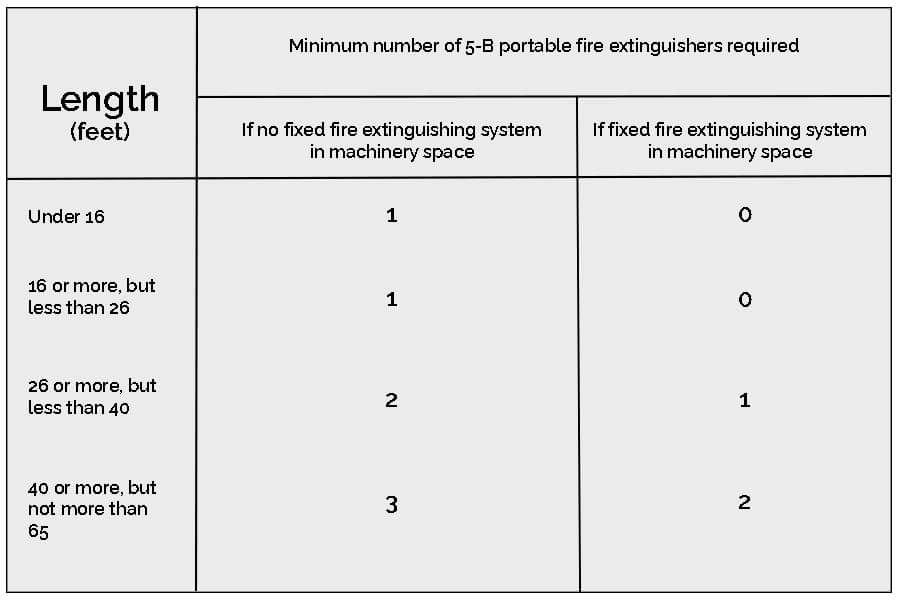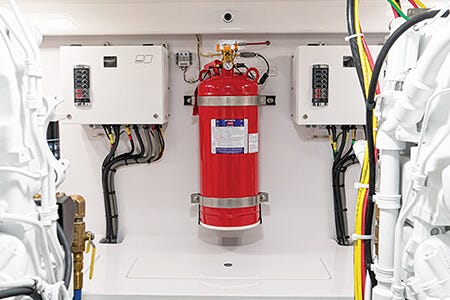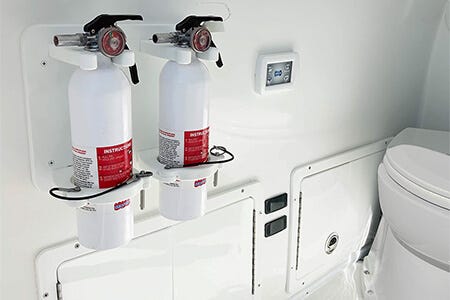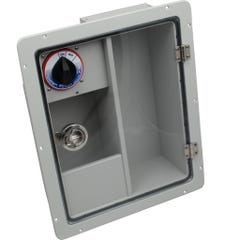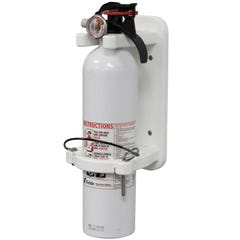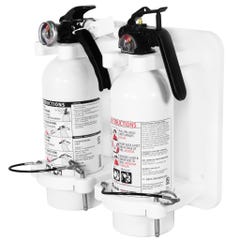What Are the Fire Extinguisher Requirements on a Boat?
November 30, 2023 6 min read


Fire extinguisher requirements for recreational boats in the United States are easy enough to look up online, but it’s worth discussing them in a little more depth. There are also some things that the law doesn’t necessarily require but that common sense does. Let’s take a closer look at how fire extinguishers on boats are stored, maintained, and used.
Contents
The Actual Regulations
Requirements for boat fire extinguishers are actually set forth in the Code of Federal Regulations. Here’s the original language of CFR 175.320:
(a) Recreational vessels 65 feet or less in length. (1) A recreational vessel 65 feet or less in length must carry at least the minimum number of portable fire extinguishers set forth in table 1 to § 175.320(a)(1). A vessel less than 26 feet in length, propelled by an outboard motor, is not required to carry portable fire extinguishers if the construction of the vessel will not permit the entrapment of explosive or flammable gases or vapors.
What Does “Fixed Fire Extinguishing System” Mean?
Looking at the table above, boats under 26 feet aren’t required to carry portable extinguishers if they have a “fixed fire extinguishing system” in their “machinery space.”
In simple terms, that means an automatic, permanent fire extinguisher on an inboard or inboard-outboard boat with the engine(s) inside the boat.
There’s no such thing as a fixed fire extinguishing system in the machinery space on an outboard boat because there is no machinery space.
There’s no such thing as a fixed fire extinguishing system in the machinery space on an outboard boat because there is no machinery space. A fixed system isn’t actually required on boats less than 65 feet, but many are built with them anyway. Fixed systems can also be retrofitted to inboard and I/O boats.
If your boat is inboard or I/O-powered and does not have a fixed system, you must carry one or more portable extinguishers. LIkewise, boats 26 feet or longer must carry one or more portable extinguishers even if they do have a fixed system.
Which Boats Aren’t Required to Carry Fire Extinguishers?
The answer, in short, is not many. The text of the regulation says boats under 26 feet with outboard power aren’t required to carry extinguishers if there’s nowhere flammable gases can get trapped.
But those places where gases can get trapped include both 1) “Double bottoms not sealed to the hull or which are not completely filled with flotation material” and 2) “Permanently installed fuel tanks.” In other words, if your boat has an open bilge area between the deck and the hull bottom, you have to carry an extinguisher. And if you have a built-in fuel tank, you have to carry an extinguisher.
Basically, powerboats that aren’t required to have at least one extinguisher are open boats with no floor and a portable fuel tank.
Basically, powerboats that aren’t required to have at least one extinguisher are open boats with no floor and a portable fuel tank — an aluminum jon boat, for example, with a small outboard, portable tank, and no deck. Note, though, that if you keep your portable tank in a closed compartment of any kind — like inside a thwart — you still have to carry an extinguisher.
The more important question, though, is why you wouldn’t carry at least one extinguisher, regardless of whether you’re required to or not. After all, it’s a minimal expense, doesn’t take up much room, and weighs only a few pounds, yet it could potentially save your property or your life.
What Type of Fire Extinguishers Are Required on a Boat?
Contrary to popular belief, there’s no such thing as a “marine” fire extinguisher. There are extinguishers marketed as marine, which may or may not be better suited to the marine environment, but in the eyes of the law, the only thing that matters is the size and class of your extinguisher(s).
The quantities of required extinguisher shown in the table above are for 5-B extinguishers specifically. The number refers to the capacity of the extinguisher — what size the extinguisher is — while the letter refers to the class of fire it is intended for. Class B is for flammable liquid fires, like burning gasoline. Class C extinguishers are for electrical fires.
Note that a single 20-B extinguisher can be substituted for two 5-B extinguishers.
New Boat Fire Extinguisher Requirements in 2022
In the spring of 2022, new fire extinguisher regulations went into effect. Here’s a quick breakdown:
- If your boat is a 2018 or newer model (check your HIN to be sure), the fire extinguishers on your boat must be labeled “5-B,” “10-B” or “20-B.” These new labels replace the old designations of B-I and B-II, which no longer count toward the requirement on 2018 and newer boats.
- If your boat is 2017 or older, extinguishers labeled B-I and B-II are still acceptable as long as they are “serviceable.” Servicable means the pressure gauge (if it has one) is in the green, the locking pin is solid, the nozzle is clean, and there’s not significant damage or corrosion.
Regardless of type and regardless of the age of your boat, if your extinguisher has a date stamped on it, it must be less than 12 years old to count toward your requirement.
Where to Store Fire Extinguishers on Boats
Curiously, the federal regulations don’t have anything to say about where to store your extinguisher(s). Common sense, though, says to store extinguishers in readily accessible locations and not to leave them rolling loose on the floor of a compartment. Fire extinguishers can be stored horizontally or vertically but should be secured in place.
Portable fire extinguishers come with a plastic mounting strap that can be screwed or bolted to the mounting surface. Generally speaking, though, these mounting straps aren’t up to marine use.
Some can deteriorate quickly from UV exposure, and almost all hold the extinguisher only around its “neck,” allowing it to bang around in rough conditions.
Fire extinguishers can be stored horizontally or vertically but should be secured in place.
Fortunately, many of today’s boats are built with convenient extinguisher lockers that hold extinguishers securely and shield them from corrosive salt spray. Aftermarket lockers are also available and can be installed in most vertical panels on a boat.
Why Worry About the Bare Minimum?
At the end of the day, these questions about minimum requirements for specific boats aren’t really that important. The fact is that fires on boats are infrequent but can be deadly. Even when they aren’t deadly, they can cause tremendous damage to your boat and your bank account. So why not take a simple, inexpensive precaution against fire by carrying plenty of fire extinguishing equipment, rather than the bare minimum?

